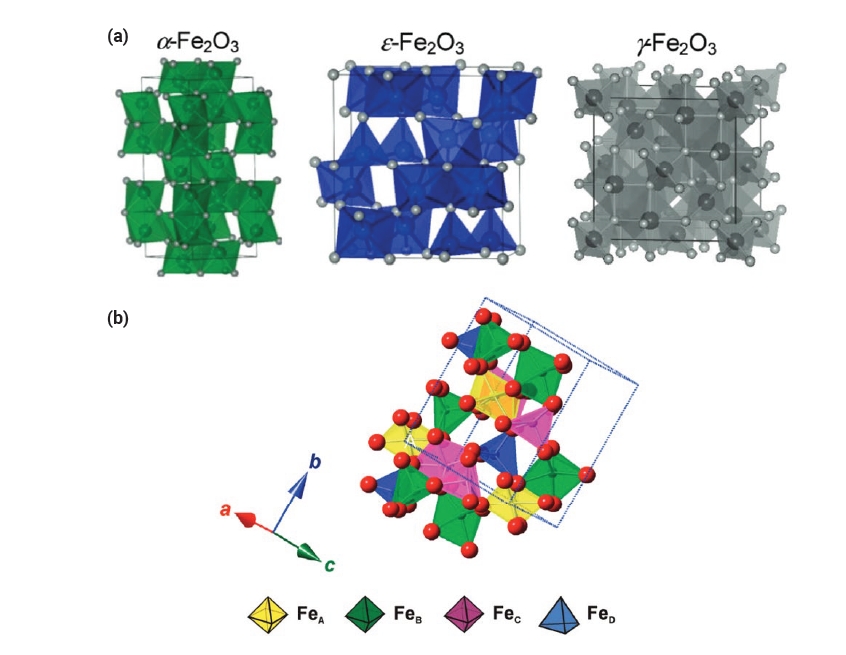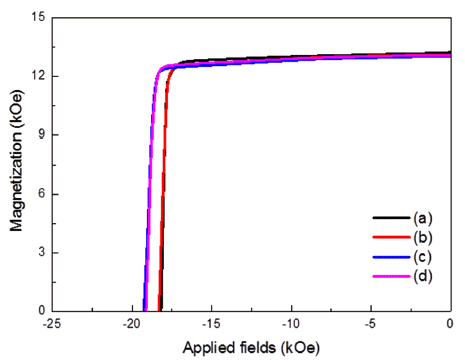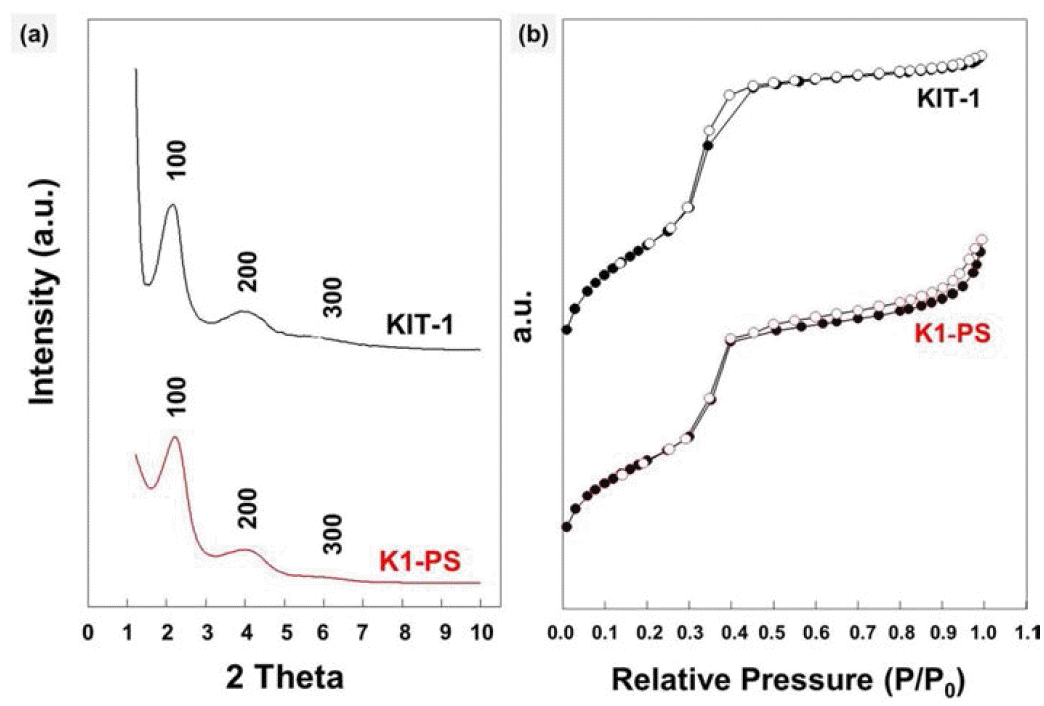- [English]
- Epsilon Iron Oxide (ε-Fe2O3) as an Electromagnetic Functional Material: Properties, Synthesis, and Applications
-
Ji Hyeong Jeong, Hwan Hee Kim, Jung-Goo Lee, Youn-Kyoung Baek
-
J Powder Mater. 2024;31(6):465-479. Published online December 31, 2024
-
DOI: https://doi.org/10.4150/jpm.2024.00290
-
-
2,432
View
-
76
Download
-
1
Citations
-
 Abstract Abstract
 PDF PDF
- Iron oxide (ε-Fe₂O₃) is emerging as a promising electromagnetic material due to its unique magnetic and electronic properties. This review focuses on the intrinsic properties of ε-Fe₂O₃, particularly its high coercivity, comparable to that of rare-earth magnets, which is attributed to its significant magnetic anisotropy. These properties render it highly suitable for applications in millimeter wave absorption and high-density magnetic storage media. Furthermore, its semiconducting behavior offers potential applications in photocatalytic hydrogen production. The review also explores various synthesis methods for fabricating ε-Fe₂O₃ as nanoparticles or thin films, emphasizing the optimization of purity and stability. By exploring and harnessing the properties of ε-Fe₂O₃, this study aims to contribute to the advancement of next-generation electromagnetic materials with potential applications in 6G wireless telecommunications, spintronics, high-density data storage, and energy technologies.
-
Citations
Citations to this article as recorded by  - Superparamagnetism of Baked Clays Containing Polymorphs of Iron Oxides: Experimental Study and Theoretical Modeling
Petr Kharitonskii, Andrei Krasilin, Nadezhda Belskaya, Svetlana Yanson, Nikita Bobrov, Andrey Ralin, Kamil Gareev, Nikita Zolotov, Dmitry Zaytsev, Elena Sergienko
Magnetochemistry.2025; 11(12): 103. CrossRef
- [Korean]
- Research trend in Fabrication of Metastable-phase Iron Nitrides for Hard Magnetic Applications
-
Kyung Min Kim, Jung-Goo Lee, Kyung Tae Kim, Youn-Kyoung Baek
-
J Korean Powder Metall Inst. 2019;26(2):146-155. Published online April 1, 2019
-
DOI: https://doi.org/10.4150/KPMI.2019.26.2.146
-
-
1,416
View
-
22
Download
-
1
Citations
-
 Abstract Abstract
 PDF PDF
Rare earth magnets are the strongest type of permanent magnets and are integral to the high tech industry, particularly in clean energies, such as electric vehicle motors and wind turbine generators. However, the cost of rare earth materials and the imbalance in supply and demand still remain big problems to solve for permanent magnet related industries. Thus, a magnet with abundant elements and moderate magnetic performance is required to replace rare-earth magnets. Recently, a”-Fe16N2 has attracted considerable attention as a promising candidate for next-generation non-rare-earth permanent magnets due to its gigantic magnetization (3.23 T). Also, metastable a”-Fe16N2 exhibits high tetragonality (c/a = 1.1) by interstitial introduction of N atoms, leading to a high magnetocrystalline anisotropy constant (K1 = 1.0MJ/m3). In addition, Fe has a large amount of reserves on the Earth compared to other magnetic materials, leading to low cost of raw materials and manufacturing for industrial production. In this paper, we review the synthetic methods of metastable a”-Fe16N2 with film, powder and bulk form and discuss the approaches to enhance magnetocrystalline anisotropy of a”-Fe16N2. Future research prospects are also offered with patent trends observed thus far. -
Citations
Citations to this article as recorded by  - Failure Cases according to Photocuring-Based Alumina 3D Printing
So-Young Ko, Shin-Il Go, Kyoung-Jun Jang, Sang-Jin Lee
Korean Journal of Materials Research.2024; 34(10): 457. CrossRef
- [Korean]
- Synthesis of DyF3 paste and Magnetic Properties of GBDPed Nd-Fe-B Magnets
-
Kwang-Won Jeon, Hee-Ryoung Cha, Jung-Goo Lee
-
J Korean Powder Metall Inst. 2016;23(6):437-441. Published online December 1, 2016
-
DOI: https://doi.org/10.4150/KPMI.2016.23.6.437
-
-
 Abstract Abstract
 PDF PDF
Recently, the grain boundary diffusion process (GBDP), involving heavy rare-earth elements such as Dy and Tb, has been widely used to enhance the coercivity of Nd-Fe-B permanent magnets. For example, a Dy compound is coated onto the surface of Nd-Fe-B sintered magnets, and then the magnets are heat treated. Subsequently, Dy diffuses into the grain boundaries of Nd-Fe-B magnets, forming Dy-Fe-B or Nd-Dy-Fe-B. The dip-coating process is also used widely instead of the GBDP. However, it is quite hard to control the thickness uniformity using dip coating. In this study, first, a DyF3 paste is fabricated using DyF3 powder. Subsequently, the fabricated DyF3 paste is homogeneously coated onto the surface of a Nd-Fe-B sintered magnet. The magnet is then subjected to GBDP to enhance its coercivity. The weight ratio of binder and DyF3 powder is controlled, and we find that the coercivity enhances with decreasing binder content. In addition, the maximum coercivity is obtained with the paste containing 70 wt% of DyF3 powder.
- [Korean]
- Synthesis of KIT-1 Mesoporous Silicates Showing Two Different Macrosporous Strucrtues; Inverse-opal or Hollow Structures
-
Youn-Kyoung Baek, Jung-Goo Lee, Young Kuk Kim
-
J Korean Powder Metall Inst. 2016;23(3):189-194. Published online June 1, 2016
-
DOI: https://doi.org/10.4150/KPMI.2016.23.3.189
-
-
 Abstract Abstract
 PDF PDF
We report a facile method for preparing KIT-1 mesoporous silicates with two different macroporous structures by dual templating. As a template for macropores, polystyrene (PS) beads are assembled into uniform three dimensional arrays by ice templating, i.e., by growing ice crystals during the freezing process of the particle suspension. Then, the polymeric templates are directly introduced into the precursor-gel solution with cationic surfactants for templating the mesopores, which is followed by hydrothermal crystallization and calcination. Later, by burning out the PS beads and the surfactants, KIT-1 mesoporous silicates with macropores are produced in a powder form. The macroporous structures of the silicates can be controlled by changing the amount of EDTANa4 salt under the same templating conditions using the PS beads and inverse-opal or hollow structures can be obtained. This strategy to prepare mesoporous powders with controllable macrostructures is potentially useful for various applications especially those dealing with bulky molecules such as, catalysis, separation, drug carriers and environmental adsorbents.
- [Korean]
- Research Trend of Ceramic Filter for Water Treatment
-
In-Hyuck Song, Jang-Hoon Ha, Byungseo Bae, Young-Jo Park, Jae-Woong Ko, Youn-Kyoung Baek, Young-Kuk Kim, Jung-Goo Lee, Yoo-Dong Hahn
-
J Korean Powder Metall Inst. 2014;21(1):62-71. Published online February 1, 2014
-
DOI: https://doi.org/10.4150/KPMI.2014.21.1.62
-
-
2,220
View
-
20
Download
-
4
Citations
-
 PDF PDF
-
Citations
Citations to this article as recorded by  - Reactive ceramic pellets incorporated iron for removing As(III), As(V), and Cr(VI) from aqueous solutions
Sunwon Rha, Yun Sik Gong, Ho Young Jo
Desalination and Water Treatment.2019; 158: 174. CrossRef - Application of Physical and Chemical Enhanced Backwashing to Reduce Membrane Fouling in the Water Treatment Process Using Ceramic Membranes
Seogyeong Park, Joon-Seok Kang, Jeong Jun Lee, Thi-Kim-Quyen Vo, Han-Seung Kim
Membranes.2018; 8(4): 110. CrossRef - Effects of particle size and forming pressure on pore properties of Fe-Cr-Al porous metal by pressureless sintering
Bon-Uk Koo, Yujeong Yi, Minjeong Lee, Byoung-Kee Kim
Metals and Materials International.2017; 23(2): 336. CrossRef - Characterization and Microstructure of an Extruded Flat-Tubular-Type Alumina Filter
Byung-Seo Bae, Jang-Hoon Ha, In-Hyuck Song
Journal of the Korean Ceramic Society.2014; 51(5): 406. CrossRef
|









